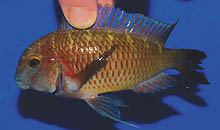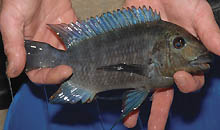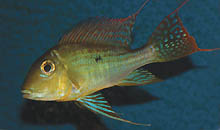WHAT'S NEW
ACROSS THE WORLD
Select date in side bar to go to a What's New of previous issues
| What's New
©by Laif DeMason
One of my high school teachers used to say: “I never believe what I hear and only half of what I see. The half I don’t believe is what I read in the newspapers”. The same could be said for the modern internet! We all know that anyone can say anything they want on the internet, but it does not make it true. All must be taken with a big grain of salt! There are many aquarium hobbyists yearning for accurate information. Fortunately there are also many hobbyists who spent years studying their fish specialties through mostly their own experiences. Many have thus compiled a vast topical reservoir of information on their particular specialty. Unfortunately, most never take the time to write down any of it. Give something back to your life long hobby. Share what you learned by experience in some form or another. First hand knowledge is always best; not what you read or were told by others. We will all be better off for it!
Here’s “what’s new” on the cichlid scene:
|
Lake Tanganyika
Collection continues on all coasts of Lake Tanganyika, but mostly in Tanzania and Burundi. Zambian and Congolese fishes are also collected but are usually now sent through Tanzania for export. Some newer and mostly harder species are still being harvested for sale. Aside from Burundi exports, long overland routes must be used to economically ferry fish for exports, reducing the likelihood of seeing any of the more delicate species.
|
what's
new: Lake Tanganyika
|

Recently exported from Tanzania, Tropheus brichardi Chungwa has interested hobbyists lately due to its color. This fish is collected near Namansi, Tanzania and can be quite aggressive towards conspecifics.
|

On rare occasions, one or two individuals of Trematocara arrive in import shipments. Here, T. variabile arrived from Burundi, but died shortly thereafter. If this genus holds any interest for you, buy whatever you can find to build your colony!
|

Tropheus moorii Muzi has been shipped from Zambia several times over the recent years. It is also called “cherry blue rainbow” due to the red and blue colors on the body. Its exact collecting location is not known, but previously thought to be near Malasa Island, Tanzania.
|

Newly collected from points south of Namansi, Tanzania, Petrochromis sp. ‘giant blue’ is a very large fish to import and thus rather expensive due to freight costs. Individuals usually arrive larger than 8 inches (20 cm) in total length.
|
Lake Malawi
Few and sporadic collections now occur along the Tanzanian coast of Lake Malawi. However, collecting continues in earnest along all the Malawi coastlines. These wild fishes can be purchased from importers, but most retailers prefer to buy the inexpensive, fully colored, small captive bred items from the breeders in the Far East.

From Nkhomo Reef, Malawi, Metriaclima cyneusmarginatum has been shipped recently. It is popular with those who enjoy “zebra” type mbuna as reportedly the females are mottled. Photo by A. Konings.
|

A small mbuna, Pseudotropheus cf. minutus from Ruarwe, Malawi has recently been caught and exported for the first time from there. This colorful little fish sports a striking stripe between eye and mouth. Photo by A. Konings.
|

A small island in the southern part of the lake, called Kanchedza, has been revealing new treasures of late. Here a new species to be shipped, Nyassachromis boadzulu is definitely a rarity one should not miss. Photo by A. Konings.
|

Also from Kanchedza Island, Protomelas virgatus is something a bit different than the normal “steveni” types that we have seen in the past. Note the green-blue colors and the lack of a yellow ventrum. Photo by A. Konings.
|
Neotropics
Seasonal collections in many South American countries are now in full swing. Many of the cichlids can now be caught in low water. In general, fishes from South America are experiencing rising popularity and thus many different fishes are collected for export. Several wild caught dwarf cichlids, geoghagines, discus, angelfish, and a few pikes are being imported.

Several species of Apistogramma are collected and shipped from South America. Often incidental types show up from time to time like this unknown species called A. sp. ‘blue diamond’.
|

Inhabiting several different rivers in the larger Amazon system, Geophagus altifrons are seasonally shipped as smaller individuals and can grow out to be beautiful adult fish.
|
Select date in side bar to go a What's New of previous issues
|









